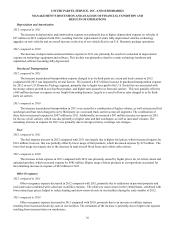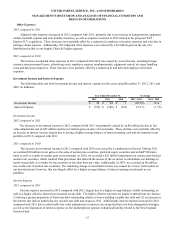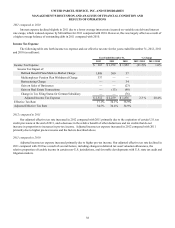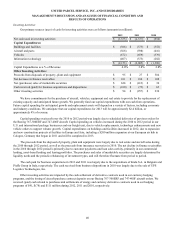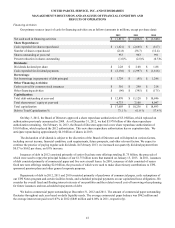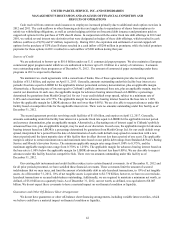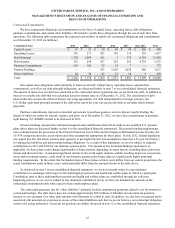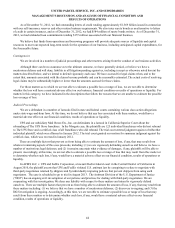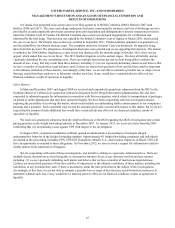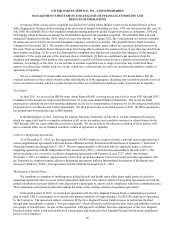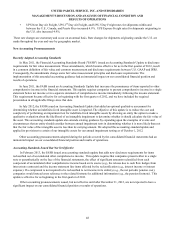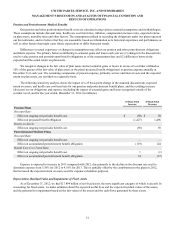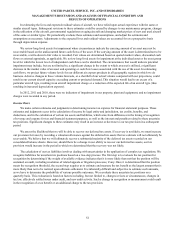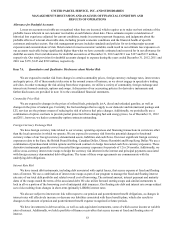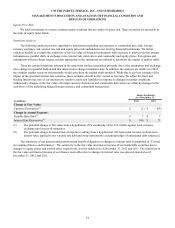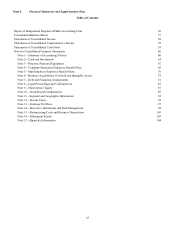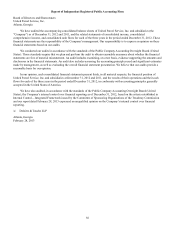UPS 2012 Annual Report Download - page 58
Download and view the complete annual report
Please find page 58 of the 2012 UPS annual report below. You can navigate through the pages in the report by either clicking on the pages listed below, or by using the keyword search tool below to find specific information within the annual report.UNITED PARCEL SERVICE, INC. AND SUBSIDIARIES
MANAGEMENT'S DISCUSSION AND ANALYSIS OF FINANCIAL CONDITION AND
RESULTS OF OPERATIONS
46
In January 2008, a class action complaint was filed in the United States District Court for the Eastern District of New
York alleging price-fixing activities relating to the provision of freight forwarding services. UPS was not named in this case. In
July 2009, the plaintiffs filed a first amended complaint naming numerous global freight forwarders as defendants. UPS and
UPS Supply Chain Solutions are among the 60 defendants named in the amended complaint. The plaintiffs filed a Second
Amended Complaint in October 2010, which we moved to dismiss. In August 2012, the Court granted our motion to dismiss
all claims relevant to UPS in the Second Amended Complaint, with leave to amend. The plaintiffs filed a Third Amended
Complaint in November 2012. We intend to file another motion to dismiss, and to otherwise vigorously defend ourselves in
this case. There are multiple factors that prevent us from being able to estimate the amount of loss, if any, that may result from
these matters including: (1) the court has dismissed the complaint once but has not considered the adequacy of the amended
complaint; (2) the scope and size of the proposed class is ill-defined; (3) there are significant legal questions about the
adequacy and standing of the putative class representatives; and (4) we believe that we have a number of meritorious legal
defenses. Accordingly, at this time, we are not able to estimate a possible loss or range of loss that may result from these
matters or to determine whether such loss, if any, would have a material adverse effect on our financial condition, results of
operations or liquidity.
We are a defendant in various other lawsuits that arose in the normal course of business. We do not believe that the
eventual resolution of these other lawsuits (either individually or in the aggregate), including any reasonably possible losses in
excess of current accruals, will have a material adverse effect on our financial condition, results of operations or liquidity.
Tax Matters
In June 2011, we received an IRS Revenue Agent Report (RAR) covering excise taxes for tax years 2003 through 2007,
in addition to the income tax matters described in note 12 to the consolidated financial statements. The excise tax RAR
proposed two alternate theories for asserting additional excise tax on transportation of property by air. We disagreed with these
proposed excise tax theories and related adjustments. We filed protests and, in the third quarter of 2011, the IRS responded to
our protests and forwarded the case to IRS Appeals.
In the third quarter of 2012, following the Appeals Opening Conference in July 2012, we had settlement discussions
which we expect will lead to a complete resolution of all excise tax matters and correlative income tax refund claims for the
2003 through 2007 tax years within the next twelve months. We do not believe the ultimate resolution of these matters will
have a material effect on our financial condition, results of operations or liquidity.
Collective Bargaining Agreements
As of December 31, 2012, we had approximately 249,000 employees employed under a national master agreement and
various supplemental agreements with local unions affiliated with the International Brotherhood of Teamsters (“Teamsters”).
These agreements run through July 31, 2013. We have approximately 2,600 pilots who are employed under a collective
bargaining agreement with the Independent Pilots Association (“IPA”), which became amendable at the end of 2011. Our
airline mechanics are covered by a collective bargaining agreement with Teamsters Local 2727, which runs through
November 1, 2013. In addition, approximately 3,100 of our ground mechanics who are not employed under agreements with
the Teamsters are employed under collective bargaining agreements with the International Association of Machinists and
Aerospace Workers (“IAM”). Our agreement with the IAM runs through July 31, 2014.
Multiemployer Benefit Plans
We contribute to a number of multiemployer defined benefit and health and welfare plans under terms of collective
bargaining agreements that cover our union represented employees. Our current collective bargaining agreements set forth the
annual contribution increases allotted to the plans that we participate in, and we are in compliance with these contribution rates.
These limitations will remain in effect throughout the terms of the existing collective bargaining agreements.
In the third quarter of 2012, we reached an agreement with the New England Pension Fund, a multiemployer pension
plan in which UPS is a participant, to restructure the pension liabilities for approximately 10,200 UPS employees represented
by the Teamsters. The agreement reflects a decision by the New England Pension Fund's trustees to restructure the fund
through plan amendments to utilize a "two pool approach", which effectively subdivides the plan assets and liabilities between
two groups of beneficiaries. As part of this agreement, UPS agreed to withdraw from the original pool of the New England
Pension Fund of which it had historically been a participant, and reenter the New England Pension Fund's newly-established
pool as a new employer.


